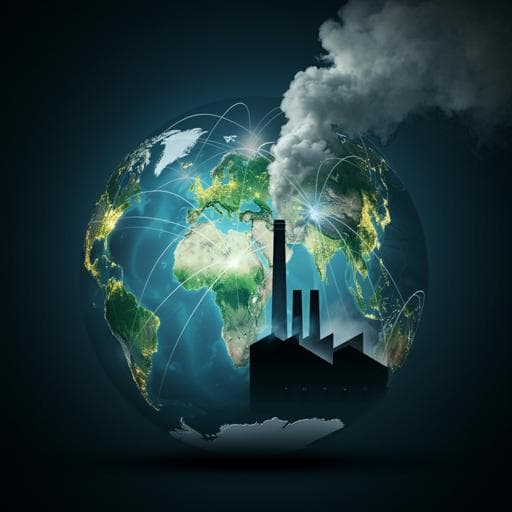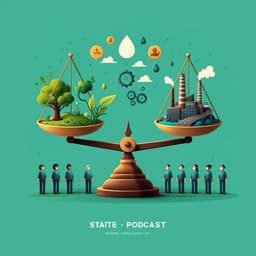
Economics
Friction or cooperation? Boosting the global economy and fighting climate change in the post-pandemic era
Z. Yang, J. Wei, et al.
This research by Zhenshan Yang, Jianan Wei, and Quansheng Ge utilizes the GTAP model to explore how trade friction is affecting global economic recovery and climate change post-COVID-19. The study reveals that trade friction not only slows down economic recovery but also hampers CO2 emission reduction efforts, particularly impacting developing economies more severely.
~3 min • Beginner • English
Introduction
The study addresses how post-pandemic trade policy choices—protectionist trade frictions versus international cooperation—affect global economic recovery and climate mitigation. It investigates the hypothesis that trade friction affects economies and CO2 emissions differently across countries and may hinder global sustainable development. Contextually, COVID-19 caused a deep, uneven global downturn and disrupted supply chains and climate cooperation. While emissions temporarily fell during lockdowns, evidence on sustained climate effects is mixed, and emissions quickly rebounded. Given ongoing supply chain stress and emerging protectionist measures, evaluating how consumption reduction, production suspension, and trade friction jointly shape GDP and CO2 outcomes across countries is crucial for guiding post-pandemic recovery and climate policy.
Literature Review
Prior work has examined economic impacts of past pandemics and COVID-19 on output, consumption, and uncertainty, typically within national contexts. Studies documented temporary global CO2 emission declines in 2020 due to lockdowns but noted limited climate impact and rapid rebounds. Literature on trade, globalization, and emissions highlights global value chains, embodied carbon transfers, and heterogeneous sectoral intensities, suggesting trade patterns materially shape national emission profiles. Emerging work considers how COVID-19 affected supply chains and low-carbon technology deployment, and how fiscal stimulus often missed green transition opportunities. However, the joint, cross-country impacts of post-pandemic trade frictions on both economic recovery and CO2 emissions remain underexplored, motivating this study.
Methodology
The study uses a multi-region computable general equilibrium (CGE) model based on the Global Trade Analysis Project (GTAP) framework to simulate post-pandemic scenarios for GDP and CO2 emissions. Four economic agents (households, firms, government, and rest of world) interact via production, consumption, trade, savings/investment, and transfers. Production uses a two-level CES nest (value added and intermediates), with value added comprising labor and capital; intermediate inputs follow a Leontief structure. Trade is modeled with CET for domestic sales vs exports and Armington CES for domestic vs imported goods; import prices include international prices, tariffs, and exchange rates. Household consumption follows Cobb-Douglas preferences; government revenue and spending include VAT, income taxes, import duties, and transfers. Equilibrium imposes market clearing for goods and factors; macro closure includes fixed exchange rate with foreign savings adjusting external balance. GDP is computed from final demands plus net exports.
Carbon emissions module: Sectoral and household CO2 emissions are calculated using fuel-specific emission coefficients, aggregating to total emissions and intensity per GDP. Emission intensity paths are fitted using historical data and macro indicators.
Data: GTAP v10 (base year 2014) is updated to 2019 using macro data (IMF) and Walmsley’s dynamic recursion for capital, population, skilled/unskilled labor, and endowments. Countries are regrouped, and 57 sectors aggregated to 19 economic sectors. CO2 data come from PRIMAP-hist; sectoral intensities are extrapolated to 2020.
Scenarios: Three nested pandemic shock scenarios (S1 low, S2 medium, S3 high) progressively add shocks: (1) consumption reduction (household propensity to consume −5/−10/−15%, with larger cuts in transport/warehousing/postal and accommodation/catering at −10/−20/−30%); (2) production suspension via labor supply reductions (−5/−10/−15%); (3) trade friction during the pandemic via export reductions (total exports −5/−10/−15%). Incremental effects are summarized via elasticity measures: production suspension elasticity (increment from S1→S2 relative to S1) and trade friction elasticity (increment from S2→S3 relative to S1).
Post-pandemic trade friction simulations: Using the S1 baseline (closest to 2020 observations), three prospective tariff scenarios raise import tax intensity globally by 5%, 10%, and 15% (T1, T2, T3) using 2019 economic and trade data to assess impacts on GDP and CO2.
Validation and error analysis: Simulated 2020 outcomes are compared with actual GDP and CO2 data. S1 best matches 2020 with average GDP error 11.0% and CO2 error 5.75%; S2 and S3 depict worse scenarios with larger deviations. The model is intended for scenario analysis rather than precise forecasts.
Key Findings
- Pandemic impacts by scenario: Global CO2 emissions decreased by 6.43% (S1), 10.72% (S2), and 15.67% (S3), confirming limited, temporary pandemic-induced emission reductions in 2020.
- Country exposure: Domestic shocks (consumption reduction and production suspension) most affected India, China, and the US due to large domestic markets and production. When including trade friction, total shock impacts were largest for the US, EU, and China across all scenarios.
- Elasticities (Table 1):
- Developing countries (India, Russia, China, Brazil) exhibit higher production suspension elasticity for GDP than trade friction, exceeding global averages, reflecting domestic-market-driven economies. India shows the largest production suspension elasticity.
- Developed countries show higher trade friction elasticity than production suspension for GDP; South Korea is most affected by trade friction, consistent with high external dependence.
- CO2 elasticities vary: Developed economies generally have higher CO2 elasticity to trade friction, except the EU in S1–S2. Australia’s CO2 is highly sensitive to production suspension. Japan’s CO2 elasticity to production suspension drops from 1.68 (S1) to 0.19 (S3). In the EU, production suspension CO2 elasticity rises from −0.11 (S1) to 3.36 (S3); consumption reduction in S1–S2 did not lower EU CO2 due to sectoral patterns (energy, transport, manufacturing ≈80% of emissions vs residential ≈20%).
- Prospective trade friction (Table 2, T1–T3 import tax rises of 5/10/15%):
- Global GDP declines: −1.89% (T1), −4.75% (T2), −8.30% (T3), with largest country/region GDP losses in the EU (−2.67%, −6.68%, −13.50%), followed by the US (−2.26%, −6.64%, −9.76%) and Russia (−2.07%, −4.34%, −6.69%).
- Short-run CO2 responses are modest relative to GDP: Global CO2 rises in T1 (+0.62%), then falls in T2 (−1.23%) and T3 (−2.16%). Some developed regions see slight CO2 increases in T1 despite GDP declines (e.g., US +0.59%).
- China and India can initially benefit in T1 economically (+0.85% and +0.48% GDP, respectively), leveraging large domestic markets; but under broader, higher frictions GDP turns negative (China −8.18% in T3; India −4.58%).
- Overall: Trade friction imposes larger negative economic effects on developed economies, while developing countries do not achieve proportional CO2 reductions from reduced trade/production. Rising trade barriers risk simultaneous economic decline and limited or even rising emissions in the near term.
Discussion
Findings show that increasing international trade frictions delay global economic recovery and yield limited, heterogeneous CO2 abatement. Developing economies are more sensitive to domestic shocks (consumption and labor supply), whereas developed economies are more exposed to trade disruptions, leading to pronounced GDP losses. Given that emissions in many advanced economies are tightly linked to traded production and transport, trade frictions can initially increase emissions (via reshoring, less efficient domestic production, or altered energy use) even as economies contract, before modest reductions appear under severe frictions. Thus, heightened protectionism risks a lose-lose outcome: deeper recessions with minimal climate benefit. The results underscore the importance of coordinated trade and climate policies, maintaining open, resilient supply chains, and accelerating low-carbon transitions across sectors to decouple recovery from emissions.
Conclusion
The study contributes by jointly assessing, within a GTAP-CGE framework, how sequential pandemic-related shocks and prospective trade frictions affect GDP and CO2 across major economies. It demonstrates that: (1) domestic shocks dominate impacts in developing countries, while trade frictions dominate in developed ones; (2) rising trade barriers substantially reduce GDP, especially in the EU and US, but yield only modest and inconsistent CO2 changes; and (3) under low levels of trade friction, some large emerging economies can temporarily offset external losses via domestic markets, but broader frictions ultimately harm them as well. Policy implications favor international cooperation and coordinated low-carbon investment and trade to achieve sustainable recovery. Future research could incorporate dynamic adjustment paths, sector-level heterogeneity and technology diffusion, alternative policy mixes (carbon pricing, green subsidies), and more granular regional disaggregation to refine impact estimates and policy design.
Limitations
- The CGE model is used for scenario analysis, not precise forecasting; results depend on assumed shock magnitudes and structure.
- Static GTAP base (2014) updated to 2019 using macro methods may not fully capture rapid structural changes by 2020–2023.
- Uniform shock levels across countries simplify heterogeneous pandemic responses and policy interventions, introducing aggregation bias.
- Exchange rate fixed; external balance adjusts via foreign savings, which may not reflect real-world exchange-rate dynamics under stress.
- Regional aggregation (main countries and EU) and sector aggregation (to 19 sectors) can mask within-region/sector heterogeneity.
- Validation shows nontrivial errors (average GDP error 11.0%, CO2 error 5.75% in S1), acceptable for scenarios but limiting precision.
Related Publications
Explore these studies to deepen your understanding of the subject.







